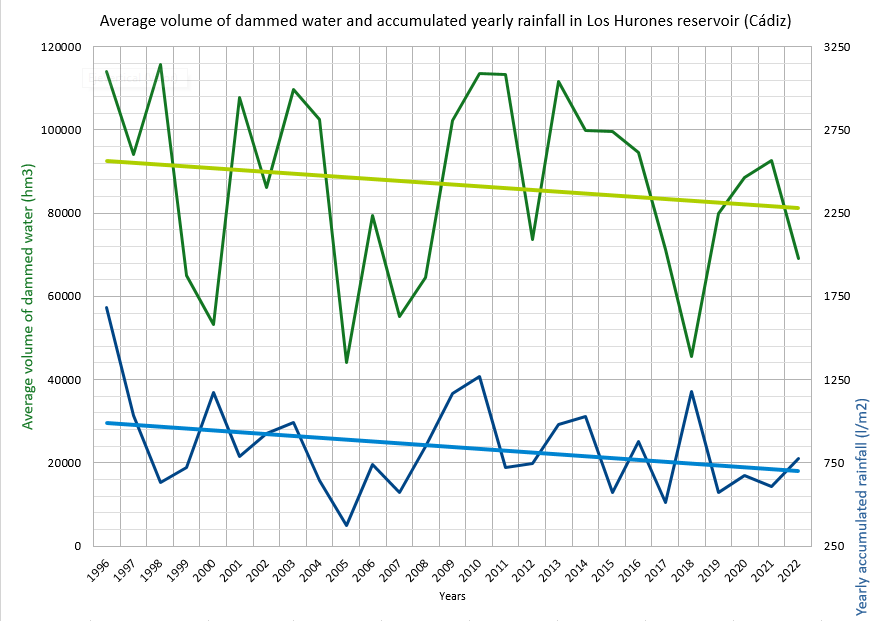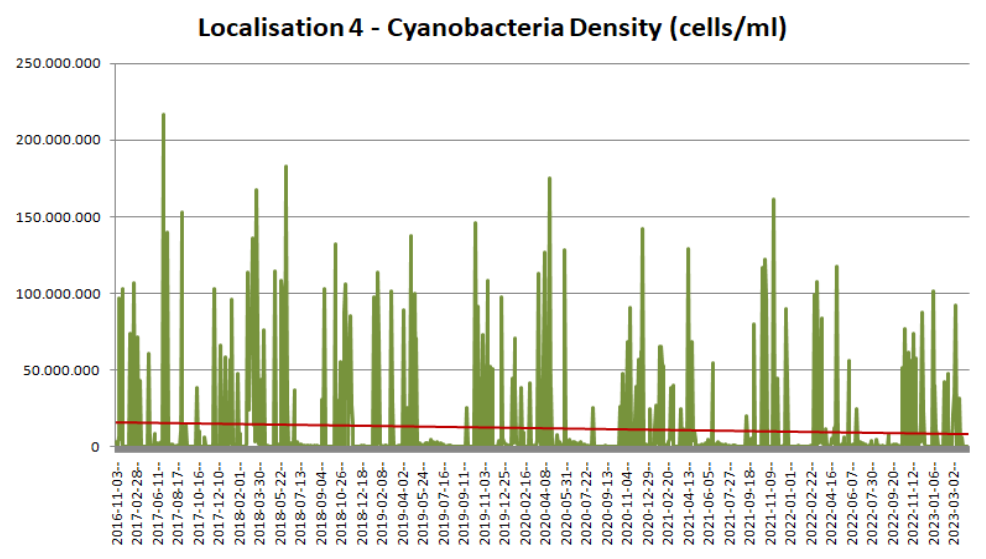Climate Detectives Projects 2022-2023
Project title: Climate change and water quality in the Los Hurones reservoir (Cádiz)
Team: Detectives Clima Hércules
IES Ciudad de Hércules Chiclana de la Frontera Spain 15 Student’s age: 14-15 years old
Does climate change affect the eutrophication and quality of supply water in Chiclana de la Frontera coming from the Los Hurones reservoir (Cádiz)?

Our project is an extension of the research undertaken in 2021-22 “Risk due to drought and water quality in Chiclana (Cádiz)” where we studied the water stress of the vegetation in four ecosystems in our town. Due to lack of time, we could not cover the study of the water quality of the reservoir from which Chiclana is supplied. This year, we have opened several lines of research.
On the one hand, we have expanded the analysis of the rainfall and temperature records provided by the Royal Observatory of the Navy, a collaborating institution with the Spanish Meteorological Agency, with historical data starting from 1870.
On the other hand, regarding the study of the quality of the dammed water, we have contacted the municipal company “Aguas de Chiclana” to find out the origin of the supply water of our town, which, except in specific moments, comes from the Los Hurones reservoir, located in the Sierra de Grazalema Natural Park, about 80 km from Chiclana. The images from the Sentinel-2 satellites allowed us to study eutrophication through various scripts that can be used from the EO-Browser platform. Eutrophication is a phenomenon that relates the enrichment of available nutrients in an aquatic environment with the growth of algae and other organisms that worsen water quality. After analyzing images from April and October 2017 with the Ulyssys, Se2WaQ (chlorophyll concentration) and Se2WaQ (cyanobacteria density) scripts, we selected the latter as it is more clearly interpretable. We conducted a qualitative study with the images available between 2016-2022. For the quantitative analysis of the evolution of the density of cyanobacteria, we requested collaboration and ESA provided us with a new version of the script that allowed the use of statistical information.
Finally, we also began the study of the images of the permanent lagoons of Doñana, which are undergoing a drying process.

RAINFALL AND TEMPERATURE RECORDS SINCE 1870:
The trend line of the average annual temperature indicates an average increase of 0.008 ºC per year. In 152 years it corresponds to 1.2ºC. The annual accumulated precipitation trend line indicates an average decrease of 1.3 litres/m². In 152 years it corresponds to 198 litres/m². Both tendencies are accentuated from the second half of the 20th century.
In the monthly records, the range of average temperatures from 20º to 30º widens, indicating an extension of the summer until mid-May and October. In accumulated rainfall, we observe a decrease in peaks since the end of the 19th century and a shift in rainfall towards spring and early autumn in the last 50 years.
VOLUME OF DAMMED WATER AND RAINFALL IN LOS HURONES SINCE 1996:
The annual accumulated rainfall trend line indicates a decrease of 11 litres/m². Between 1996-2022 that represents 286 liters/m² (37% of the precipitation of 2022). The trend line of the average volume of dammed water indicates a decrease of 430 hm3/year. Between 1996-2022 that represents 11,000 hm3 (16% of the 2022 volume).
CYANOBACTERIA DENSITY SINCE 2016:
We measured it at four locations in the reservoir close to the mouth of the rivers coming from Ubrique-Benaocaz and El Bosque-Benamahoma, and from streams that cross nearby crop fields.
The graphs, in all locations, show minimum levels in summer and in December 2018 and January-February 2022, months without rainfall. Therefore, and contrary to expectations, the flowering peaks do not appear to be related to temperature but rather to the contribution of nutrients from rainfall (which can carry fertilizers from the crops), transfers from the Guadiaro river (also polluted) and incorrect operation of wastewater treatment plants (without removal of nitrogen or phosphorus). Decreasing trend lines of cyanobacteria density detected in all locations are consistent with drought.

Our research has led us to organize a group of “Climate Activists” in our school, in which we are developing various environmental awareness and action projects:
*** “Where do you throw your rubbish?”: it is an awareness campaign on the importance of separating waste and also on its reduction, accompanied by various actions (in the playground, in the corridors and in the classrooms of our school). We are involving volunteer students to set up information and supervision teams.
*** “What are your environmental footprints?”: it is an information campaign in which we explain to students, teachers and families how to understand and calculate their own carbon, water and plastic waste footprints. We are also developing a statistical study with the aim of raising awareness about the effects that our individual and collective habits have on the environment and how we can mitigate them with small changes in our lifestyle.
*** Installation of a new weather station on the roof of our institute connected to international networks to be able to produce local statistics.
Participation in the initiative Research in the Classroom of the Granada Science Park on April 21, 2023, where we have presented our lines of work.
*** Participation in scientific calls such as the II Chiclana Science Fair and the V Week of Sciences and Humanities of our center.
*** Communication in the media and in particular on the school’s radio.
*** Publication on the website of our school of the results of our project to inform the entire educational community, including families.
*** Organization of impact actions that disseminate the results of our research and information and awareness campaigns for the celebration of World Environment Day on June 5.
https://ciudaddehercules.es/index.php/detectives-del-clima/
Projects are created by the teams and they take the full responsibility of the shared data.
← All projects







